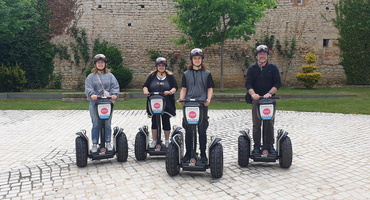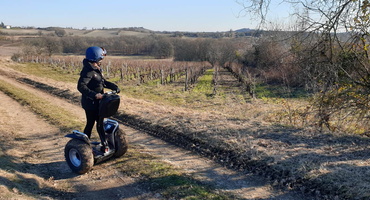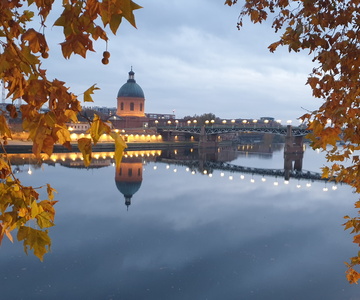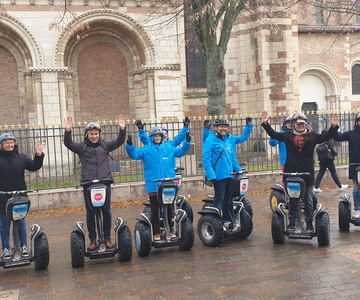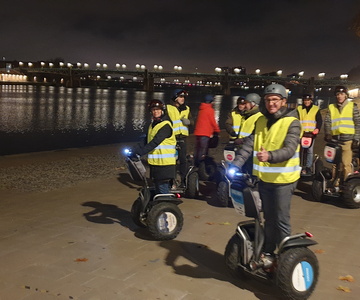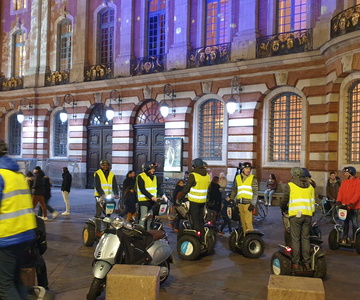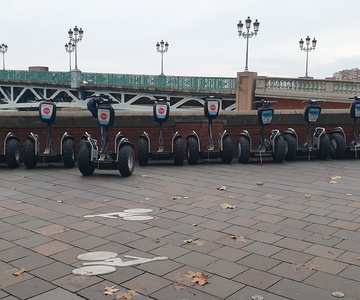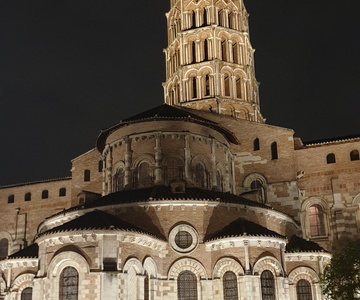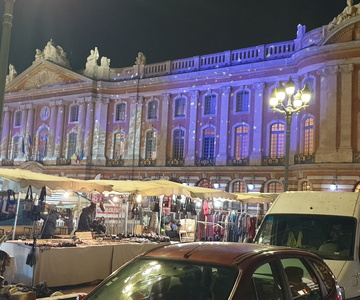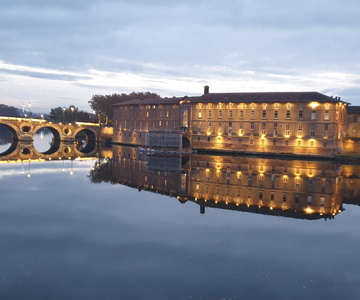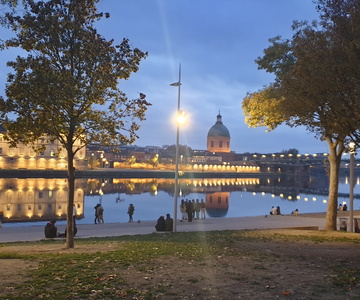Toulouse Segway tour 2 hours in gyropode
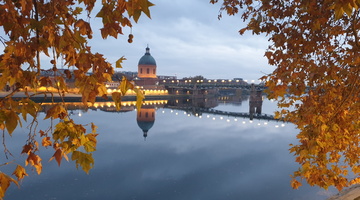
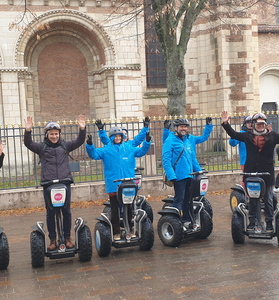
Accessible from 12 years old.
Strong points
- Place Saint Pierre
- Place de la Daurade
- The banks of the Garonne
- Hotel Dieu Saint Jacques
- The place of the Capitol
- The Wilson square
- The Victor Hugo market
- The Basilica of Saint Sernin
- Convent of the Jacobins
Place Saint Pierre (our meeting place)
Place Saint-Pierre takes its name from the proximity of the Saint-Pierre des Cuisines church, one of the oldest churches in the city. In the Middle Ages, when the square was not yet developed, there was a small river port, called the Bidou (or Vidou) port, named after a person of that name who, living on the Chapelle-Hugolèse square (where the current no. 26 place de la Bourse is), had a garden near the Garonne. In 1794, during the French Revolution, it was given the name of Voltaire, the philosopher of the Enlightenment, but it did not survive.
Place de la Daurade and port
The Daurade district takes its name from the decoration of a chapel built by the Visigoth kings when they established Toulouse as the capital of their kingdom. The building dedicated to the Virgin Mary was demolished in 1761 and replaced by the current Notre-Dame basilica. The walls of the chapel were covered with a mosaic of glass tesserae fixed on a gold leaf background. In Occitan "golden" is said "daurat", hence the name given to the church and the district. A fragment of this mosaic discovered during excavations in 1960 is preserved in the Calvet Museum in Avignon.
The port of La Daurade was used for local trade during the Middle Ages for boat transport on the Garonne. The port was also the place of activity of the "sand fishermen" equipped with flat-bottomed boats. They went up the Garonne with a pole and filled the boat with sand with a long-handled shovel in the shape of a weeder, to unload it along the quay. The masons would come to get it with dumpers to use it in the mortar of the joints between the bricks.
The port also hosted the wash boats of the professional laundresses, the drying racks of the linen occupied a part of the quays.
Hotel Dieu Saint Jacques
It houses the headquarters of the hospitals of Toulouse and the Functional Directions. It has become a place of strategic decisions and influence of the hospital activity.
The headquarters of the Toulouse Hospitals is located at the Hotel Dieu Saint Jacques, where the life of the CHU's authorities takes place and where financial, economic and social political decisions are made. This establishment also plays an essential emblematic role in the hospital community, affirming its identity and opening it up to its environment.
In addition to the General Management and the Functional Departments that it houses, the Hôtel-Dieu is also home to the headquarters of the European Institute of Telemedicine, the European Research Center on Skin and Coating Epithelia (Pierre Fabre Institute), and the headquarters of the Association of Friends of the Hôtel-Dieu Saint-Jacques et de la Grave, whose mission is to contribute to the maintenance of the architectural heritage. It also houses the Museum of the History of Medicine and the Museum of Medical Instruments.
In 2000, the Hôtel-Dieu Saint-Jacques was inscribed on the UNESCO World Heritage List (Pilgrimage routes to Santiago de Compostela).
Place du Capitole It is the most emblematic place in Toulouse. The Place du Capitole is the landmark of the Toulousans and the star of the postcards. The seat of municipal power for more than eight centuries, the illustrious eponymous monument is home to the City Hall and the Capitol Theater. But this site also hides many secrets.
Five little-known facts about Toulouse's Place du Capitole.
The Capitole has its own dungeon... And this one dates from the 16ᵉ century. It was in 1525, after 60 years of work on the ruins of the great Capitole fire, that the Capitouls decided to build this keep, also called the Consistory Tower. The objective was to protect the archives and gunpowder in anticipation of an invasion of Languedoc by the Spaniards during the war between Francis I and Charles V. With the tower of the archives, it is one of the only two pieces that have survived the ages and the bad weather. For the anecdote, the dungeon of the Capitole also had its role to play in the famous Calas affair since Jean Calas was interrogated there in 1761.
As you approach the Grande Porte du Capitole, you may have noticed the little bell hanging on one of the street lamps. Figure it was already there in the 19ᵉ century! On market days, it was rung at the beginning and end, when the sales stopped. This sound signal was used, among other things, to notify people from very modest backgrounds that they could go and collect unsold goods from shopkeepers. Hence the name "clochard!
There is a little bit of Italy on the Capitole in Toulouse. Above the main entrance of this elegant building are eight magnificent columns of red Carrara marble. This material comes straight from this region, located in the Apuan Alps, northwest of Tuscany in Italy. A place well known for the incomparable quality of its marble. The marble columns of the Capitol are all the more important because they symbolize the first eight capitols. And for good reason, in those days, Toulouse was divided into eight districts: the "capitoulats", each managed by a capitoul.
Have you ever thought of looking up when you were walking under the arches of the Capitole? You could learn more about the history of the pink city. Above the heads of passersby are several paintings by the painter Raymond Moretti. Each one represents a personality of Toulouse, historical events, or specialties of the city. The emblematic Toulouse singer Claude Nougaro is represented on several occasions. A beautiful tribute to the singer, who is a friend of the painter.
The Place du Capitole is rich in symbols. One of the most emblematic: the Occitan cross. It is a Greek cross with four branches ending in three balls, a total of 12 balls. This cross being a symbol of Christianity, the 12 balls traditionally referred to the 12 apostles. As for the Toulouse square, the 12 signs of the zodiac, the 12 months of the year and the 12 hours of the day are represented.
For good reason, the cross that covers the center of the capitol square is rather recent. It was made in 1995 by the French painter and sculptor Raymond Moretti. Moreover, we can distinguish two different tracings. The more granular one refers to the artist's line while the smooth and shiny one is the one of the final work. Made of bronze, the Occitan cross reflects the sunlight on the square. The next time you walk over this cross, think of it as stepping on 20 tons of bronze.
History of Wilson Square Wilson Square is named after Thomas Woodrow Wilson who served as President of the United States from 1912 to 1920. Involved with his country in the First World War in 1917, it was on July 14, 1918 that the city of Toulouse made the decision to name the square after him. Thomas Woodrow Wilson has also been an honorary citizen of the Pink City since that time. In the Middle Ages, it was here that the consuls and Simon de Montfort met during the siege of 1216. The square was then only a meadow located outside the ramparts, the latter being closed by the Villeneuve gate.
In 1562, after the fighting of the "Délivrance", the Protestants left through this gate when they were driven out of the city. To prevent a possible return of the banished, the Catholics of Toulouse condemned the gate. In 1778, the capitouls decided to reopen the gate. In 1783, the city's new architect, Jacques-Pascal Virebent, submitted a project for a double square, both inside and outside. The construction work finally began in 1788, with a gigantic gate in the middle. However, the French Revolution stopped the work.
The Lafayette square was created in 1876 and was at that time encircled by a grid surrounding a sculpture: Moses breaking his fetters. The fountain located in the middle of the square welcomes a splendid statue of Clémence Isaure on May 23, 1908. During the years 2005 and 2006, the place starts to be pedestrianized and the number of lanes for cars goes from two to one. In 2007, the carousel, present for 17 years on the Saint-Georges square, is installed on the Wilson square.
Victor Hugo Market This traditional covered market takes place every day except Monday from 7 a.m. to 1:30 p.m. If there is one market you should not miss in Toulouse, it is this one! It is one of the most popular markets in the city. More than 80 exhibitors share the stands and offer an unlimited choice of fresh and regional products. Fishmongers, butchers, pork butchers, tripe makers and poulterers rub shoulders with greengrocers, bakers and pastry makers, cheese makers and cream makers. But you will also find caterers, wine merchants or very good spice and olive stands. You can eat on the go by sitting on one of the barrels of the market but the originality of the place lies in the restaurants installed on the second floor of the hall, which highlight the local products sold on the first floor.
Basilique Saint Sernin The largest Romanesque church in France, this monumental jewel registered as a heritage site by UNESCO has been welcoming pilgrims on their way to Santiago de Compostela for centuries.
One of the symbols of Toulouse, this brick and stone basilica is impressive. Majestic and luminous, it was built between the 11th and 14th centuries in honor of Saint Saturnin (or Sernin), the first bishop of the city. An important stage on the pilgrimage to Santiago de Compostela, it is an invitation to meditation and its vast proportions are conducive to wandering among the many reliquaries.
A 21-meter high nave with a barrel vault resting on richly sculpted capitals leads to the choir and its gilded wood and marble baldachin. In the richly decorated transepts, one discovers moving medieval frescoes.
One can also access the crypts where it is possible to admire the enamelled reliquary of the True Cross, in the form of a sarcophagus.
An exceptional example of southern Gothic architecture, this brick giant houses the relics of Saint Thomas Aquinas in the shade of its giant palm tree.
The Jacobins Convent A jewel of medieval art. Gigantic building, both sober and original, it keeps a unique church. Of austere aspect on the outside, it strikes inside by its luminosity, the lightness of its vaults and its double nave which ends by a spectacular stone palm tree with 22 ribs.
Under its altar are kept the relics of the Dominican Thomas Aquinas. Its walls are entirely painted in trompe l'oeil to imitate marble, more noble than brick.
The cloister, the old refectory, the chapel of the Virgin and the chapel of Saint Antonin, places of freshness and tranquility, also host concerts and exhibitions.
| Duration |
2 hours
|
| Rate / person | From 57 € |
| Difficulty |
Very easy
|
| Minimum age |
12
|
Details of the formula
The package includes
Good to know
ABOUT THIS ACTIVITY
Group size: 6 people
Language : French
PRACTICAL INFORMATION
How it works
Book directly online, by email (midi-quercy@mobilboard.com) or by phone at +33 6 43 18 86 24.
The duration of our tours includes a preliminary introduction to the Segway.
You have the possibility to book a private tour only by phone (minimum 4 persons) from 65€.
For your safety, all our tours are supervised by an approved Segway instructor.
Minimum weight 45 kg and maximum 118 kg.
From 12 years old
We reserve the right to interrupt the session of one or more persons in case of bad behavior.
Agency accessibility Mobilboard Midi-Quercy
The meeting point is directly at Place Saint Pierre on the self-service bicycle side
